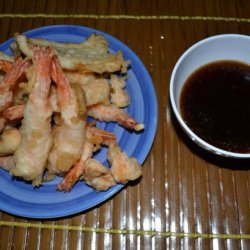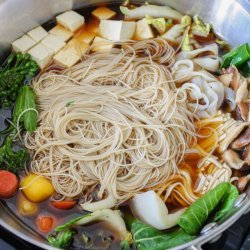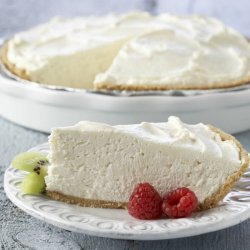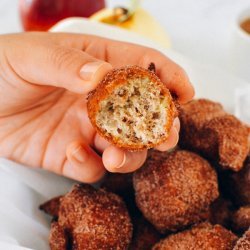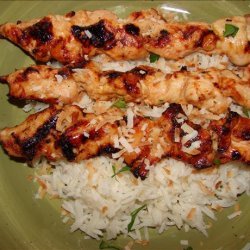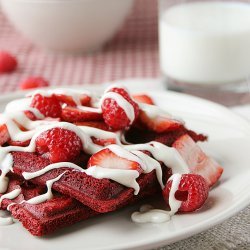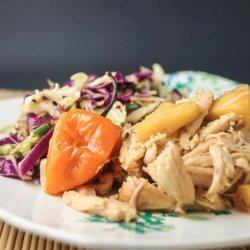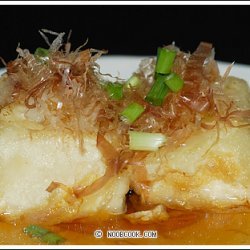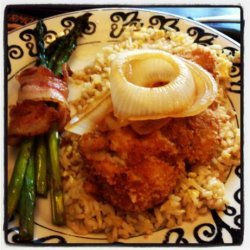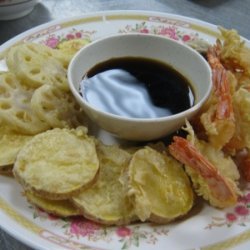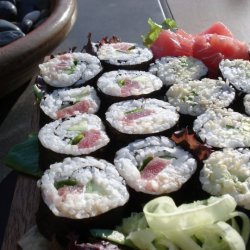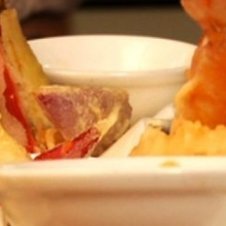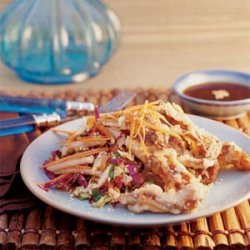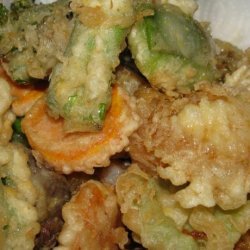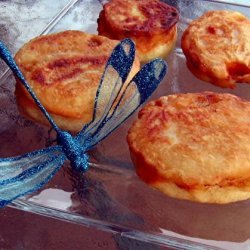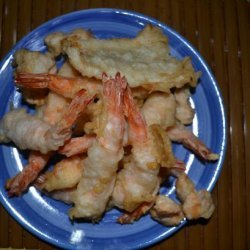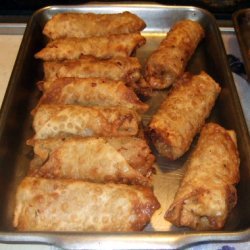Ingredients:
- seasonal fish and vegetables are used in tempura. the ingredients for tempura in the recipe below are only a few of the many, many common ingredients that lend themselves to this treatment. shrimp; squid; small whole fish like perch, smelt , and goby; white-fleshed saltwater fish; eggplant; green beans; onion rings; sweet potato slices; bell pepper strips; mushrooms - the list could go on for several pages. chicken, beef and pork, however, are not usually prepared as tempura because of their relatively heavier, identifiable taste. chicken and pork are deep-fried in other ways, and beef is often given a more highlighted preparation, say
- http://japanesefood.about.com/od/tempura/a/cookingtempura.htm
- prepare the ingredients.
- heat vegetable oil in a deep pan to 340-350f degree.
- lightly dip ingredients in the batter and immediately fry them until crisp. it takes longer to fry vegetables than to fry seafood.
- drain tempura on a rack.
- serve right away with tentsuyu (tempura dipping sauce) or salt. tempura is best served hot. *grated daikon radish is a common condiment.
- http://japanesefood.about.com/od/tempura/r/tempurabatter.htm
- 1 egg
- beat an egg in a bowl. add ice water in the bowl. be sure to use very cold water.
- add sifted flour in the bowl and mix lightly. be careful not to overmix the batter.
- makes 4 servings
- tempura dipping sauce is called tentsuyu in japanese. serve this sauce with tempura.
- put mirin in a pan and heat. add soy sauce and dashi soup stock in the pan. bring the sauce to a boil.
- tips for making crispy tempura
- by setsuko yoshizuka
- use ice water for the batter. this is really important to prevent the batter from absorbing too much oil.
- do not make the batter ahead of time. try not to over mix the batter and not to coat ingredients with the batter too much.
- tip 3: frying serving
- if you are frying both seafood and vegetables, fry vegetables first. then, fry seafood. fry vegetables at 340f degree and fry seafood at 350f degree.
- to check the temperature of frying oil, drop a little batter into the oil. if the batter comes up right away instead of sinking to the bottom of the pan, it's about 360 f degree. if the batter goes halfway to the bottom and comes up, it's about 340f degree. this is said to be the right temperature to fry tempura.
Directions:
- Tempura Variations:
- Tempura Shrimp Recipe - Japanese Recipe
- Ingredients:
- 12 large shrimps
- 1 egg
- 1 cup all purpose flour
- 1 cup ice water
- Vegetable oil for frying
- Preparation:
- Remove heads and shells from shrimps without removing tails.
- Devein the shrimps. Make two or three incisions in the stomach sides of the shrimps to straighten them. Lightly press the back of shrimps to straighten.
- Remove the dirt from the tails of shrimps, using a knife. Dry shrimps on paper towels.
- Make tempura batter.
- Heat the oil to 340F degree.
- Flour shrimps before frying.
- Dip the shrimps in the tempura batter.
- Fry the shrimps until crisp.
- =====================================================
- Kakiage Recipe
- Kakiage is a kind of tempura which different ingredients are mixed together in tempura batter before deep-frying. Various vegetables, mushrooms, and seafood can be used for kakiage.
- Ingredients:
- 1 onion, thinly sliced (about 2 cups)
- 1/2 large carrot, cut into thin strips (1/2 cup)
- 1/4 lb scallops, shredded
- 1 egg
- 1 cup ice water
- 1 cup all purpose flour
- *Vegetable oil for frying
- Preparation:
- Beat an egg in a large bowl.
- Add ice water in the bowl.
- Add sifted flour in the bowl and mix lightly.
- Heat oil to 340 degrees F in a deep pan.
- Add onion slices, carrot strips, and scallops in the tempura batter, and mix together.
- Take a scoop of the mixture with a large spoon and slip into the oil.
- Shape the piece, using chopsticks or a cooking tong until firm.
- Deep-fry until browned on both sides.
- Drain and serve with tempura dipping sauce.
- =====================================================
- Tempura
- Ingredients:
- 4-8 medium shrimp
- 6-inch (15cm) piece raw squid
- 4-8 small sillago (kisu) fillets, or fillets of small white-fleshed fish
- 2-3 medium onions
- 4-5 inches (10-13cm) lotus root
- 4-8 shiitake mushrooms or white mushrooms, wiped and trimmed
- 1-2 sweet potatoes
- 4-8 shiso leaves
- 15-16 stalks trefoil
- Dipping sauce:
- 1 cup dashi
- 1/3 cup mirin
- 1/3 cup light soy sauce
- 1 cup grated giant white radish (daikon oroshi)
- Few tsps finely grated fresh ginger
- Batter:
- 2 egg yolks
- 2 cups ice water
- 2 cups sifted flour
- Oil for deep frying
- 4 servings
- To prepare: Shell and devein shrimp, but leave tails attached. Chop off the tips of shrimp tails and gently press out moisture from shrimp with the flat of the knife tip. To prevent shrimp from curling as they are deep-fried, make a few deep incisions along the belly, as shown, and then lightly tap across each shrimp with back of knife blade.
- Cut squid into 1 1/2-inch (4cm) squares, then cross-score the outer, smooth side of each piece lightly.
- Use the sanmai oroshi technique (pp 123-) for sillago or other small fish, but in this case stop the knife at the base of the tail and cut off and remove the central bone as close to the tail as possible. The result is 2 fillets attached to a tail. This may be tricky, and is mainly decorative anyway; it is no disaster if the fillets have no tails. Clean and pat dry sillago fillets. If you are using fillets of a large white-fleshed fish, remove bones and cut fillets crosswise into bite-sized pieces.
- Pierce onions with toothpicks then cut into rounds, as shown, to keep rounds from falling apart into rings.
- Scrape lotus root and slice into rounds. Place immediately in weak vinegar-water to prevent discoloration.
- If mushroom caps are very large, cut in half.
- Peel sweet potato and slice crosswise into rounds.
- Wash and pat dry shiso leaves.
- Hold 3 or 4 trefoil stalks together and tie into a knot just below leaves. Trim off stalks about 1 1/2 inches (4cm) below knot.
- Prepare the dipping sauce by combining ingredients over heat and bringing just to a boil. Keep warm.
- Grate radish and ginger.
- To deep-fry: Make the batter in 2 batches, the first batch just before you are ready to begin deep-frying, as you are waiting for the oil to heat. In a mixing bowl, lightly beat 1 egg yolk, then pour in 1 cup of ice water and give this a few strokes. Add 1 cup sifted flour all at once. Stroke a few times with chopsticks or fork, just till ingredients are loosely combined. The batter should be very lumpy. If you overmix, the batter will be sticky and the coating will turn out oily and heavy. Mix the batter with the least amount of movement. Make the second batch of batter as the first is used up.
- The oil should be fairly hot, about 340° F/170° C. Test by dropping a tiny bit of batter into the oil; it should descend slightly beneath the surface of the oil, then be buoyed up to the surface, the oil gently bubbling round its edges.
- When you begin to deep-fry, set up the area around the heating unit like an assembly line: a tray or several trays of foods to be fried, a container of flour for dipping, and the batter bowl at your left; the hot oil pot at center; the rack for draining and skimmers and chopsticks and slotted spoons, at right. Try to arrange the physical layout and your timing to serve the tempura immediately after frying, but if you cannot, keep foods hot.
- Each food item progresses through the assembly line in this way; use fingers to dip food in flour, shake off excess, then dip in batter; lay or slide coated material in hot oil and deep-fry till golden, around 3 minutes, turning in the oil for even cooking. Retrieve with slotted spoon or cooking chopsticks and briefly drain before transferring to serving plate. Skim the surface of the oil occasionally to keep it clean. Stir batter once or twice as you work, to keep it from separating.
- Begin with vegetables, then move on to shrimp and fish or other foods that need a higher oil temperature.
- There are exceptions to this flour- and batter-coating process - shiso leaves, nori seaweed and knotted trefoil are not dipped in flour and are batter-coated on the back side only. If these are completely covered with batter, their color or texture would be lost.
- To serve: A bar-type arrangement that allows you to serve diners directly from the stove or from a deep-fryer at a sideboard is ideal for tempura. Diners should be provided with a plate or bamboo tray lined with absorbent paper on which tempura is placed as it is done. If, on the other hand, you have to bring the deep-fried food from kitchen to table, arrange 8 or 10 pieces of tempura (2 shrimp, 2 fish, and several vegetables) on paper-lined places or trays and serve that way.
- At the table, pour hot dipping sauce into a small bowl, mix in grated daikon and a bit of grated ginger, if desired. Dip tempura in this sauce and eat.
Nutrition Facts
| Amount Per 1 Serving | |||
| Calories | 199.66 Kcal (836 kJ) | ||
| Calories from fat | 24.05 Kcal | ||
| % Daily Value* | |||
| Total Fat | 2.67g | 4% | |
|---|---|---|---|
| Cholesterol | 42.1mg | 14% | |
| Sodium | 1202.18mg | 50% | |
| Potassium | 245.29mg | 5% | |
| Total Carbs | 30.27g | 10% | |
| Sugars | 3.92g | 16% | |
| Dietary Fiber | 2.13g | 9% | |
| Protein | 9.57g | 19% | |
| Vitamin C | 0.6mg | 1% | |
| Iron | 1.6mg | 9% | |
| Calcium | 96.2mg | 10% | |
| Amount Per 100 g | |||
| Calories | 99.17 Kcal (415 kJ) | ||
| Calories from fat | 11.95 Kcal | ||
| % Daily Value* | |||
| Total Fat | 1.33g | 4% | |
|---|---|---|---|
| Cholesterol | 20.91mg | 14% | |
| Sodium | 597.14mg | 50% | |
| Potassium | 121.84mg | 5% | |
| Total Carbs | 15.03g | 10% | |
| Sugars | 1.95g | 16% | |
| Dietary Fiber | 1.06g | 9% | |
| Protein | 4.75g | 19% | |
| Vitamin C | 0.3mg | 1% | |
| Iron | 0.8mg | 9% | |
| Calcium | 47.8mg | 10% | |
* Percent Daily Values are based on a 2000 calorie diet. Your daily values may be higher or lower depending on your calorie needs.
Find out how many calories should you eat.
Get Your Recipe of Health!
Follow RecipeOfHealth on Facebook!


